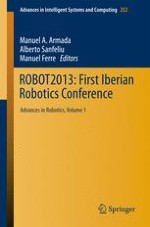This book contains the proceedings of the ROBOT 2013: FIRST IBERIAN ROBOTICS CONFERENCE and it can be said that included both state of the art and more practical presentations dealing with implementation problems, support technologies and future applications. A growing interest in Assistive Robotics, Agricultural Robotics, Field Robotics, Grasping and Dexterous Manipulation, Humanoid Robots, Intelligent Systems and Robotics, Marine Robotics, has been demonstrated by the very relevant number of contributions. Moreover, ROBOT2013 incorporates a special session on Legal and Ethical Aspects in Robotics that is becoming a topic of key relevance. This Conference was held in Madrid (28-29 November 2013), organized by the Sociedad Española para la Investigación y Desarrollo en Robótica (SEIDROB) and by the Centre for Automation and Robotics - CAR (Universidad Politécnica de Madrid (UPM) and Consejo Superior de Investigaciones Científicas (CSIC)), along with the co-operation of Grupo Temático de Robótica CEA-GTRob, "Sociedade Portuguesa de Robotica" (SPR), "Asociación Española de Promoción de la Investigación en Agentes Físicos" (RedAF), and partially supported by "Comunidad de Madrid under RoboCity2030 Programme".
